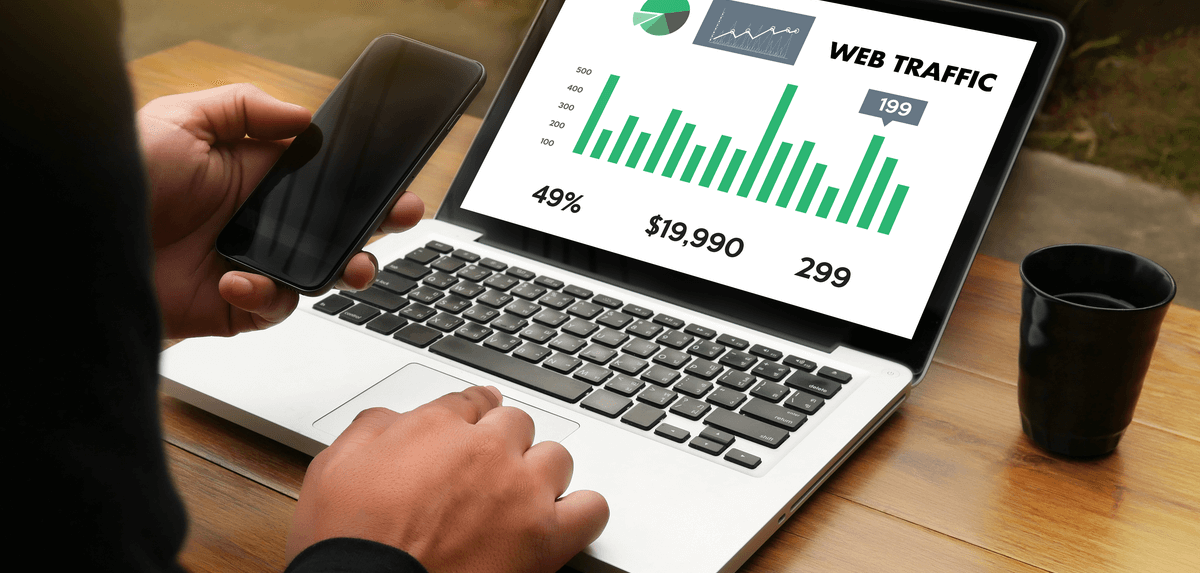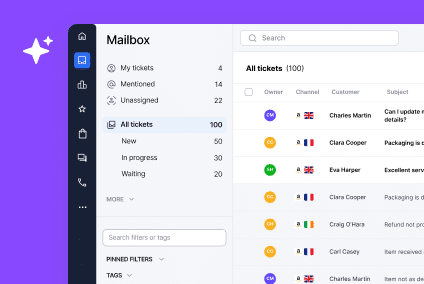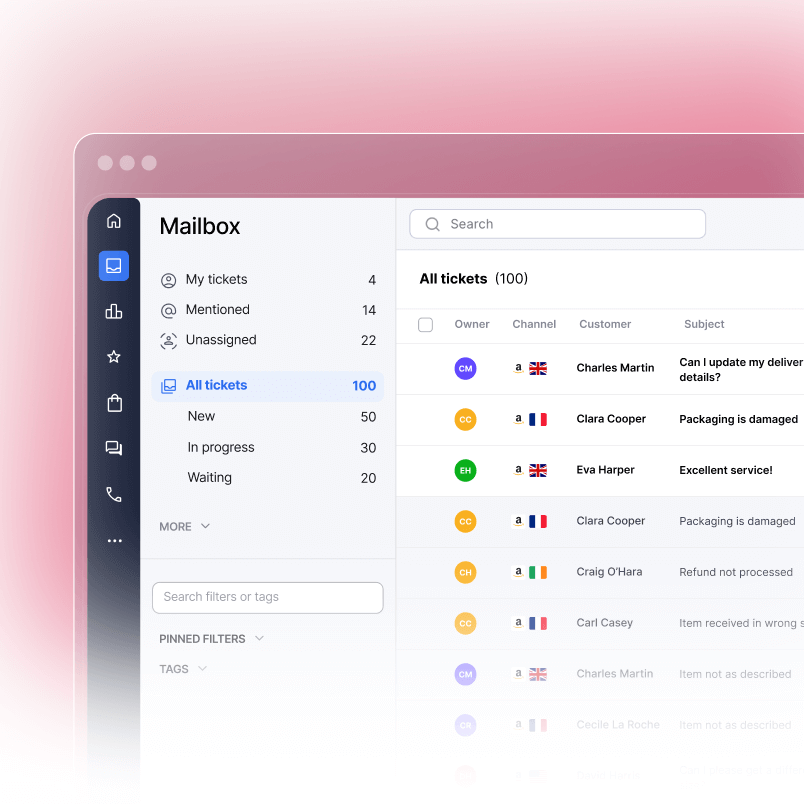It’s never been easier for eCommerce entrepreneurs to set up an online store. There are over 5.7 million Shopify stores already in existence, and that number is set to grow even higher! The simplicity of setting up a new store is great for newcomers, but it also means increased competition for everyone else. Discovering how to drive traffic to Shopify store is something that every eCommerce business should be focused on. Here’s how to get traffic to your Shopify store in 2025.
1. Use Advanced SEO to Increase Your Store’s Visibility
Learning how to improve your Shopify store’s SEO (search engine optimization) so that it appears on the first page of organic results in Google, Bing and other search results can significantly increase Shopify traffic. With 63.31% of all web traffic now coming from mobile devices and 53% of all website traffic originating from organic search, optimizing your store for search engines has never been more critical.
While Shopify does a lot of heavy lifting when it comes to SEO, you can go well beyond this and get the most out of the platform. First things first, find out what keywords your competitors rank for. This will help you determine what words you want your potential customers to search for when learning how do people find your Shopify store.
A great way to start is by using advanced keyword research tools, such as Google Keyword Planner, SEMrush, or Ahrefs. These Shopify store tools provide deeper insights into search volume, competition levels, and keyword difficulty scores that weren’t available in 2021.
Once you have listed the keywords you want to rank for, you can work them into your website’s content, including page titles, product descriptions, images and more. Customer intelligence can help with keyword research as well. Try listing at least five main areas that your customers care about and that are closely linked to your products before brainstorming around these to come up with ideas of search terms that your customers might commonly use.
Taking inspiration from social media hashtags related to your products, visiting product forums and taking a sneaky look at the titles, meta titles and image alt-text used on competitors’ sites will also help you build a picture of the most likely words and phrases entered into search engines to track down your product range.
Once you have listed the keywords you want to rank for, you can work them into your website’s content. Don’t overstuff your content so that it reads unnaturally, as this is off-putting to both buyers and Google’s SEO algorithms. Use keywords only as often as necessary, and don’t forget to combine a mixture of individual words and long-tail phrases, including questions, that buyers are likely to type when using a search engine.
Voice Search Optimization: With 20% of voice searches activated by just 25 specific keywords, optimize your content for conversational queries and question-based searches. Only 13% of marketers are incorporating voice search optimization into their strategies, presenting a significant opportunity for early adopters.
Spending some time making your Shopify site structure as easy to navigate as possible so that shoppers can quickly and easily find the items they’re looking for will also help with SEO, as they’ll stay for longer and will also visit more pages.
A simple structure is always a winner, with products located as few clicks as possible away from your homepage (try homepage > category page > subcategory page > product).
Adding a brief ‘about me’ section to your site, along with a comprehensive ‘contact me’ pag,e will help build trust. This establishes you as a reliable and committed Shopify store that cares about eCommerce customer service.
Site speed is also important for SEO, so be sure to choose a mobile-friendly theme, use small, optimized images, remove any apps you’re not currently using and avoid adding carousels or sliders to display your products. Shopify’s Web Performance dashboard now provides advanced insights into your store’s loading speed and performance metrics.
Improving the performance of your Shopify store is critical to get more traffic. You should always be measuring your site metrics to find areas that need attention. If you’re not tracking and evaluating your Shopify store’s performance, you’re effectively working in the dark.
2. Build Customer Engagement Through AI-Enhanced Content Marketing
A surefire way to reach and interact with more consumers is by producing high-quality, useful content that piques their interest and addresses their specific needs. This can be anything from well-written, SEO friendly long-form blog posts to podcasts, videos and social media campaigns powered by AI insights. It must be relevant to your target audience, showing how your products can help solve their problems.
Publishing regularly builds engagement with your audience and increases the entry points to your online store. Writing fresh content between two to three times per week has been shown to increase your search engine ranking. This will help new potential customers discover your site when they are browsing the web or searching for products from online sellers like yourself!
AI-Powered Content Creation: Leverage artificial intelligence tools to analyze customer behavior patterns, predict trending topics, and create personalized content recommendations. Modern Shopify store software can now integrate with AI platforms to automatically generate product descriptions, blog post ideas, and even complete articles based on your industry and customer preferences.
Content marketing for eCommerce businesses isn’t just writing about the products you sell. Think about how you can provide value-added content that enhances the customer experience at different stages in their journey. For example, if you sell motorbike parts, you could publish an article on the best European destinations for motorbiking or create interactive guides using AR technology.
Video Content Strategy: With YouTube’s 2.5 billion users and 78% of TikTok users purchasing products showcased by influencers, video content has become essential to drive traffic to your Shopify store. Create product demonstrations, behind-the-scenes content, unboxing videos, and user-generated content campaigns.
Tapping into your audience’s interests and producing something they’ll want to share is key. Keep in mind, however, that a good content strategy is not about quick wins. It requires patience and commitment over the long haul. You might not get more traffic immediately; it could take a few weeks or even months for some posts to get traction.
Interactive Content: Implement quizzes, polls, and interactive product configurators to increase engagement. For example, a skincare brand could create a quiz that helps customers identify their skin type and receive personalized product recommendations, significantly improving how people discover and connect with your Shopify store.
3. Dominate Social Commerce and Emerging Platforms
Your target audience is on social media, so you should be, too—but the landscape has dramatically evolved since 2021. Social commerce generated $570.7 billion in 2024 and is projected to exceed $1.085 trillion by 2028, making it essential to drive traffic to your Shopify store.

While established eCommerce companies may have the resources to spread themselves across many different social media platforms, smaller startups with limited resources would be better served by focusing strategically on platforms where their audience is most active.
TikTok and Short-Form Video: TikTok has emerged as a powerhouse for product discovery, with 78% of users purchasing products showcased by influencers on the platform. Almost 60% of U.S. marketers plan to use Instagram Reels for influencer marketing in 2025, indicating the growing importance of short-form video content.
Facebook Continues to Convert: Despite the rise of newer platforms, Facebook still maintains the highest conversion rate for all social media eCommerce traffic at 1.85%. With more than 2.37 billion monthly active users, Facebook remains a solid foundation for driving traffic, with nearly two-thirds of all social media visits to Shopify stores coming via Facebook.
Instagram Shopping Evolution: Instagram has experienced phenomenal growth and now offers advanced shopping features, including Instagram Shopping, product tags, and checkout capabilities. The platform’s integration with Shopify allows for seamless product discovery and purchase without leaving the app.
Emerging Platforms: Don’t overlook newer platforms like Pinterest for visual products, LinkedIn for B2B, or emerging social commerce features on platforms like Snapchat and YouTube Shorts. The key is understanding where your specific audience spends their time and how do people find your Shopify store through these channels.
Whatever route you choose when utilizing social media to get more traffic to your Shopify store, include calls to action and links to your product pages in all posts. Also, make sure you have an eCommerce helpdesk that’s able to integrate with the channels you’re using. This will enable you to communicate with all your customers from a single, centralized location.
Social Proof and User-Generated Content: Encourage customers to create content featuring your products. Run hashtag campaigns, contests, and collaborate with micro-influencers who often have higher engagement rates than macro-influencers.
4. Leverage Advanced Paid Advertising and Automation
The paid advertising landscape has become more sophisticated and data-driven since 2021. Modern advertising strategies for increasing Shopify traffic involve multi-channel approaches, advanced targeting, and automation technologies that weren’t widely available before.

Google Ads Evolution: Google’s introduction of Smart Shopping campaigns (now Performance Max) and AI-powered bidding strategies has revolutionized how businesses advertise their products. These campaigns automatically optimize across Google’s entire ecosystem, including Search, Display, YouTube, Gmail, and Discover.
Meta Advertising (Facebook and Instagram): The Meta advertising platform now offers advanced features like Advantage+ campaigns, which use machine learning to optimize ad delivery across Facebook and Instagram automatically. The platform’s detailed targeting options allow you to reach highly specific audience segments based on behavior, interests, and demographics.
TikTok Advertising: As TikTok’s user base has grown to over 1 billion users, its advertising platform has matured significantly. TikTok Ads Manager now offers sophisticated targeting options, automatic optimization, and various ad formats including TopView, Brand Takeover, and In-Feed Video ads.
Retargeting and Customer Journey Optimization: Advanced retargeting strategies now involve creating custom audiences based on specific actions users take on your site. You can retarget people who viewed specific products, abandoned their cart, or spent a certain amount of time on your site.
Affiliate and Influencer Marketing Automation: Modern Shopify store tools now include sophisticated affiliate tracking systems. Affiliate marketing has become the top acquisition channel for 40% of US merchants, with partnerships driving significant traffic through authentic recommendations.
Email Marketing Integration: Research shows that for Shopify stores, email generates the best conversion rate at 4.29%, compared to search (3.04%), direct (2.93%), and social (1.81%). Modern email marketing platforms integrate with your Shopify store to create automated sequences based on customer behavior, cart abandonment, and purchase history.
Finding and working with the most respected and popular content creators in your particular market remains a solid strategy. However, the approach has become more data-driven and performance-focused. Tools such as Creator.co and AspireIQ make it quick and easy to find the right influencers for your business and track campaign performance.
Additionally, it’s important to do your homework when it comes to finding the right personality and the right platform to promote your product. Modern influencer marketing involves micro-influencers (1K-100K followers) who often have higher engagement rates and more targeted audiences than mega-influencers.
Investing in an influencer can sometimes be quick, easy and affordable. Sending free samples of your product might be all it takes to get a shoutout on Instagram from one social media maven, while others might only work with businesses that share their philosophy and values.
Final Thoughts
If your site traffic is in the doldrums, ignore sales for now. Focus on building brand awareness through these modern strategies, and customers will come.
Even if your Shopify store is performing well, you still should be focusing on how to get traffic to your Shopify store. Taking your foot off the gas can have adverse consequences, so make sure you’re constantly working on your site’s visibility using the latest 2025 strategies.
The digital landscape has evolved significantly since 2021, with new platforms, technologies, and customer behaviors reshaping how to drive traffic to your Shopify store. Success in 2025 requires a multi-channel approach that combines advanced SEO techniques, AI-enhanced content marketing, strategic social commerce, and sophisticated paid advertising.
Key trends to remember include the dominance of mobile traffic (63.31% of all web traffic), the importance of voice search optimization, the explosive growth of social commerce, and the increasing effectiveness of AI-powered marketing automation. Businesses that adapt to these changes while maintaining focus on customer experience will see the most success in driving consistent, high-quality traffic.
Once visitors to your Shopify store increase, ensure you’re providing the best possible shopping experience by using an eCommerce help desk to respond to customer support queries quickly and accurately.
eDesk integrates seamlessly with Shopify. You can answer all of your customer queries from every marketplace, channel and web store you sell on from one single mailbox. Discover advanced AI tools for eCommerce automation to stay ahead of 2025 trends.
Book a free demo to learn more about how eDesk can optimize your customer service operations.




